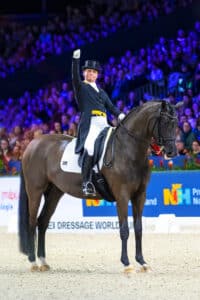There’s no escaping it – the square halt is in every dressage test. If it’s been a thorn in your side, CHRISTINE ARMISHAW has some sound advice.
It’s the one movement that always shows up, in the same part of every dressage test, right at the very end: the square halt. Many tests also require a square halt at the beginning and others incorporate the odd one in the middle too, so if you can consistently nail this movement your score will love you for it!
What is a square halt? Simply put, it’s when the horse comes to a complete stop with a leg at each corner. The FEI Judge’s Handbook states: ‘At the halt the horse should stand attentive, engaged, motionless, straight and square, with their weight distributed over all four legs. The neck should be raised with the poll at the highest point and the nose slightly in front of the vertical’. If the nose is lower than this, the crest will end up higher than the poll, so you don’t want your horse overbent, or you will be marked down.
You’re also judged on the transitions in to and out of the halt, including the regularity of paces before and after, along with maintenance of suppleness, continuation of a soft and elastic contact, and your horse’s willingness to perform the exercise in harmony with you. With these halt goals in mind, here are some training techniques to help perfect your square halt.
Execution: Firstly, they need to be forward and on the aids. You’re looking for snappy responses to your go aid, with your horse moving briskly forward within approximately two seconds once you’ve asked. If the go response is sloppy and dull, coming into a halt will likely be the same. If your horse is lacking in energy, try a few halt to trot transitions in fairly quick succession to liven them up. These halts don’t have to be square; the emphasis here is on the crispness of the transition and your horse’s quick responses to your stop and go aids.

Using guide poles to help with straightness and immobility (Image by Oliver Armishaw-Webb).
Once they are alert and willing, it’s time to put more focus into getting a leg at each corner. Ensure you are riding a straight line, then pick a spot ahead of you to halt. About three strides out, take a big breath in. As you breathe out, tense your core, slightly tilt your pelvis forward under your body and shift your weight a little toward the back of the saddle, aiming to distribute your weight over their hindquarters and off the forehand. Close your fingers firmly around the reins and hold this overall closed hand and tense body position until your horse has come to a complete halt.
Treat it like you are riding their energy forward into the halt, rather than pulling back into it. Keep your legs wrapped around their sides, not pushing but maintaining that completion of the forward movement. This helps to finish with both hind legs under the body, rather than one left trailing out behind. Ideally, the whole movement should be completed between two to three strides. Once halted, let the pressure off.
Troubleshooting: If your horse always seems to leave a leg behind, usually it’s due to not being forwards enough as you come down the line, so avoid gradually slowing as you approach your halt point. Also, never correct an uneven stance by reining back, backward steps are a big no-no. Always ride forward into the halt.

Competition done and won, but Isabell Werth and Weihegold OLD still halt square (Image © FEI/Leanjo de Koster).
Your body should stay balanced and centred in the saddle, with your weight even across both stirrups and seat bones. However, if you find your horse tends to swing their quarters out to one side, try weighting the opposite stirrup a touch more. Sometimes a rider is inadvertently sitting with their weight off to one side and correcting this can be an easy fix for a horse that swings out.
Another tip to help with a lack of straightness is to set up two poles to halt between. Move them further apart as your horse gets better at the exercise, until you can finally remove them altogether.
Daily integration: Knowing square halts always show up means you should incorporate them into everyday riding life. Yes, absolutely train your square halts during some deliberate and intentional sessions, but don’t just leave practise until then. Every time I stop, I ask my horse to stop square. This includes at the end of every single ride, be it flatwork schooling, a jump session or a trail ride. It also applies when pausing to adjust stirrups or tack, halting before hopping off to rearrange a fence or pick up a pole, or stopping for pretty much any other reason.
If you make square the standard you expect when your horse becomes stationary, you will find the movement gets progressively easier to execute and the likelihood of nailing all those square halts and bumping up your dressage marks will increase too.
Now pop over to Equestrian Hub training section for video content demonstrating these techniques.
Feature Image: Lyric and Christine nailing their square halt at the 2022 Sydney Eventing Spring Classic (Image by Elegant Exposures Photography).



